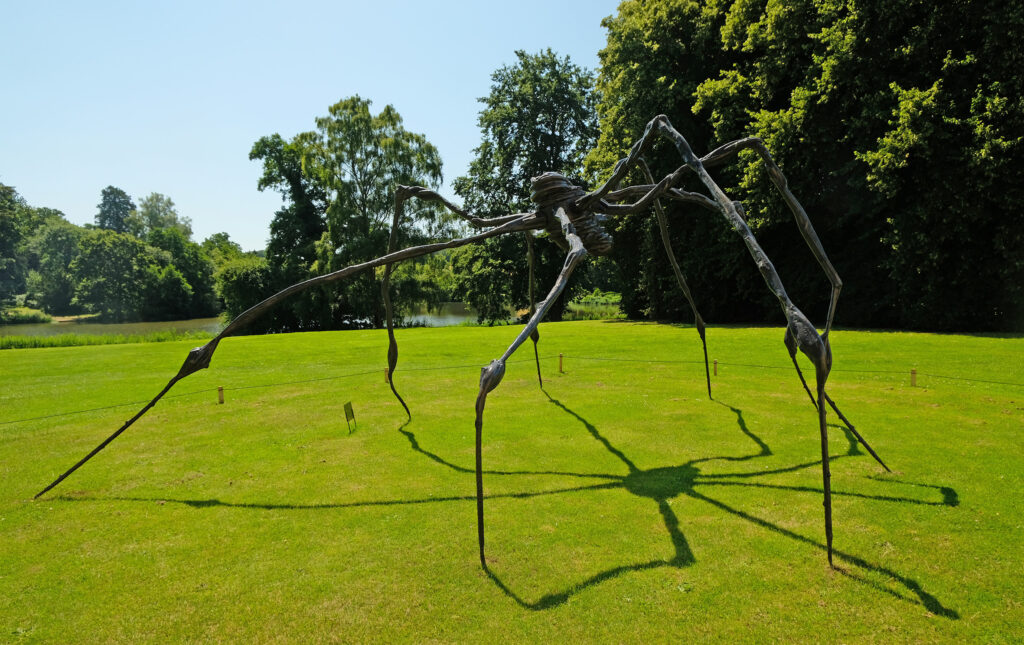
Warwickshire’s Compton Verney has been taken over by giant spiders, swinging figurative sculptures and fluid flower paintings. They are among 40 works being exhibited as part of ‘Nature Study’, a major retrospective celebrating the career of great French-American artist Louise Bourgeois.
Bourgeois is best known for her arachnids and fans of hers will not be disappointed, while unsuspecting visitors may be in for a shock; a big bronze spider crawls up the walls of the mansion’s entrance hall.

Making itself at home, the creature carries layers of meaning, about which the late artist spoke:
“Like a spider, my mother was a weaver. My family was in the business of tapestry restoration, and my mother was in charge of the workshop. Like spiders, my mother was very clever. Spiders are friendly presences that eat mosquitos. We know that mosquitos spread diseases and are therefore unwanted. So, spiders are helpful and protective, just like my mother”.
Protective but predatory, ferocious yet nurturing; the spider is defined by such dualities, a theme which runs throughout Bourgeois’ practice and this show. Upstairs, oppositional forces continue to be found; a wall of colourful spiral prints points to an artist both winding inwards and expanding outwards in acts of expression.
Over the course of her life, Bourgeois consistently turned to art as a means of therapy, using it to work through complex emotions, face childhood trauma and make sense of her innermost self. “I know that when I finish a drawing, my anxiety level decreases,” she once said.

In a show of surprises, highlights include several symbolic landscape paintings. While she never identified as a surrealist, Bourgeois was influenced by the movement which dealt with dreams and the unconscious mind. In ‘Untitled’, 2004, white ladders balance in a strange world of her imagination, reaching from bodily humps into a blue sky above.

Nature also takes on anthropomorphic qualities in ‘Les Fleurs’, 2009. Working on wet paper, Bourgeois allowed chance to create pools of pink and rounded forms which she connected to tender stems in a suite of 9 gouache paintings. While resembling plants, the abstracted compositions also suggest internal organs and the 5 blooms on each branch are meant to represent members of her own family: both the one she was raised in and the one she had.
In the same room is a cabinet of small and curious sculptures, titled ‘Topiary’, 2005. Female figures grow out of tree stumps, and leaves sprout from figurines, as if caught in the act of metamorphosis. They recall women in Greek myths, including Daphne who escaped Apollo’s pursuit by shape-shifting into a laurel tree.
More explicit references can to mythology are found in works on paper, including an intricate print, ‘The Three Graces’, 1998-2002, in which three women’s bodies have been transformed into trees which form a united orchard, their branches overlapping to become one. Bourgeois takes stories and makes them her own; in this case, the three graces seem to represent her own trio of roles – as artist, wife and mother.

This exhibition takes viewers deep into the mind of Bourgeois, who was still making art at the age of 97. In an isolated room stands ‘Lair’, 1962, a bronze sculpture painted white, which acts as a manifestation of her earlier spiral drawings. It’s surrounded on every side by large scale works on paper, ‘À l’Infini’, 2008-9, made at the very end of her life. Across white paper, meandering red lines, floating figures and gestural marks evoke nature’s roots growing and twisting, like the artist’s unbounding imagination.
The artist’s imagination has not been limited to temporary exhibition spaces, either, but has taken over the entirety of Compton Verney with works placed in dialogue with the permanent displays. Within the Portraits and Miniatures Collection hangs her black and white photograph, taken by Robert Mapplethorpe; smiling at viewers, with a mischievous gleam in her eyes, Bourgeois seems happy to be lurking here.


Outside, the Capability Brown landscape has also been disrupted by Bourgeois. On the lawn is another enormous spider, its 7-metre wide bronze body contrasting with the white façade of Georgian manor, while hidden deeper in the woods a silver couple dangle from the branches of a tree, dappled by light and moving in the breeze.

Bourgeois’ artworks are not alone; they have been installed within a wider sculpture park, where contemporary, radical work by the likes of Sarah Lucas, Helen Chadwick and Permindar Kaur are dispersed, inviting visitors to explore 120 acres of the grounds and enjoy immersive art adventures which feature a horse and carriage, overgrown house and Naked Venus by the large lake.
The pastoral setting of Compton Verney is the perfect venue for an exhibition exploring the ways in which Bourgeois was inspired by the natural world. Wrapping itself around the house and gardens, Nature Study is a spellbinding show for an extraordinary artist who, like her spiders, spun magical structures to serve herself, while captivating her viewers.
Louise Bourgeois: Nature Study runs until Sunday 6 Oct and is included in the price of a ticket to Compton Verney.


